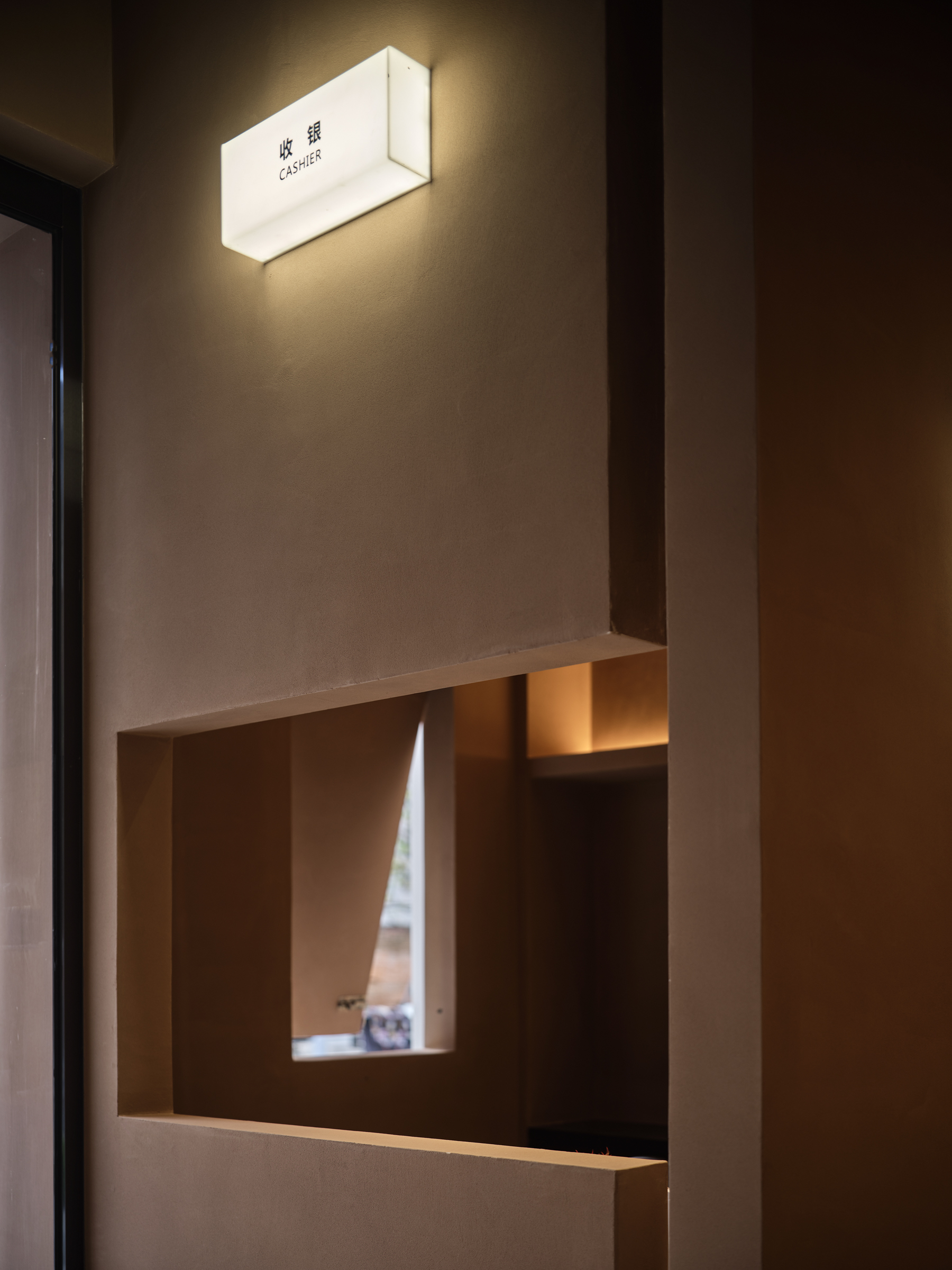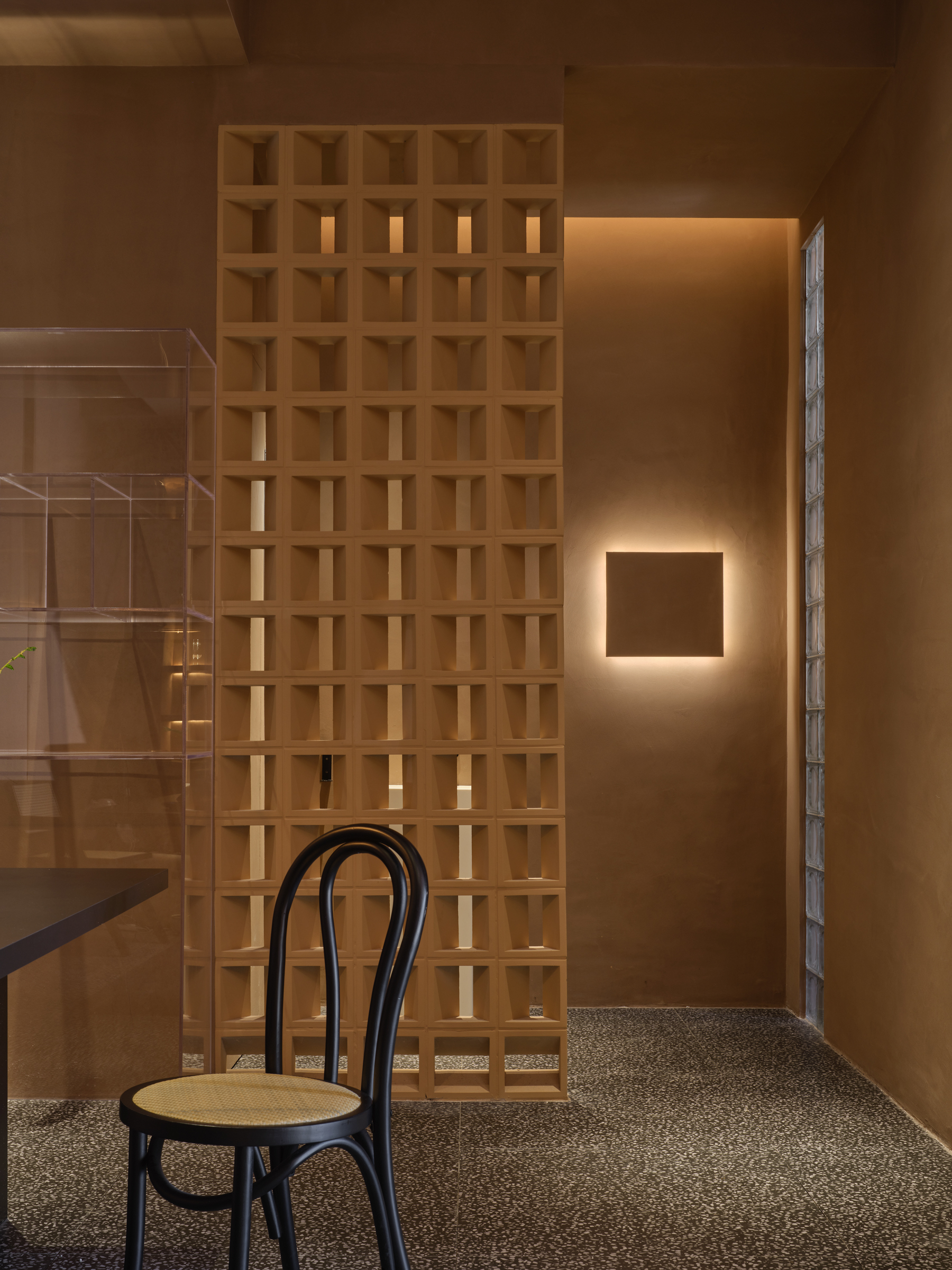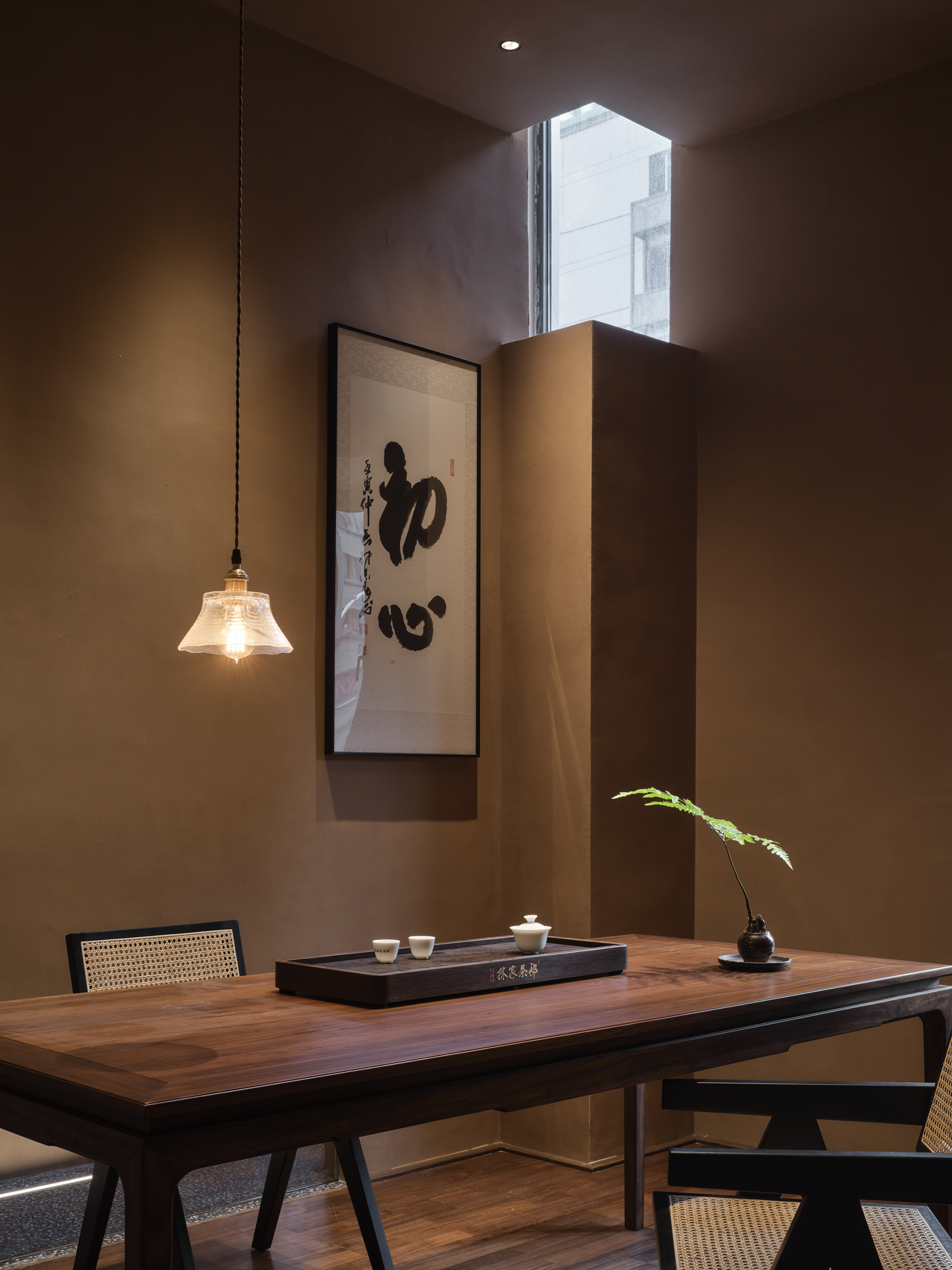

主案设计 VHD + 何吴龙吉设计研究室
项目地址 福建福州
完成时间 2022年2月
项目面积 200平方米
本文文字由设计单位提供。
原初而静谧的世界
“凉台静室,明窗曲几,松风竹月,晏坐行吟,清谭把卷。”此为明朝陆树声在《茶寮记》中所求的理想品茶环境。是故,福州乌山林家茶邸,既把茶饮本身之质作为首要标准,亦注重营造清灵之气集的品茗氛围,以期为往来茶客,提供一方释怀山水离觞之梦的净土。
"Quietness prevails in the room and balcony. By the bright window, besides an antique table, good friends sit together, chanting and singing cheerfully, with books in their hands; outside, a fair moon hangs above, and the sounding of whistle echoes among the pine trees." These phrases came from The Story of Tea House, written by Lu Shusheng of Ming Dynasty, who depicted an ideal tea tasting scene he longed to pursue. Lins’ Tea House, located in Wushan of Fuzhou, intends to create such environment for all tea lovers. Here, you may enjoy perfect tea tasting atmosphere while sipping our high-quality tea. The teahouse is built aiming to provide a quiet resting area for visitors, to give them a chance to reveal their souls in beautiful landscape.


彼得·卒姆托曾说:“当你喜欢一些材料并坦诚地去接触它的时候,你会把它用得很好,很温暖亲切。”木、石、玻璃、粘土等多种材料并置,刚柔相依,古今相融,虚实相连,共同塑造了这一当代茶空间。
"If you love a certain type of material, then embrace it honestly, and you may use it well, with warmth and affability." Peter Zumthor once said. Wood, stone, glass, clay and other materials are juxtaposed together, which creates a scene integrating with rigidity and softness, converging ancient days with modern times, and connecting illusion with reality, thus helping shape this contemporary tea space.

设计师通过对项目业态、场域、近旁、文化等了解后,将本空间立意为一场“归与望”——始于传承,展望未来,归去来兮,茶半香初。
Through better understanding business type, domain, proximity structures and culture connotations of this project, the designer finally decided to endow this space with a theme — Return & Prospect: by returning to our tea tradition while looking into the future, the fragrance of tea is as the same as it is originally brewed.



整个空间师法自然,纯粹提色于武夷山的茶与岩。大量接近茶汤又兼和大地的同一土色,奠定了沉稳宁静的基调,释放出一种苍润、素雅、静谧的空间气质。
The whole tea space takes Nature as the source — painted with the color resembling tea and rock in Mount Wuyi. A large patch of earth tone close to tea as well as the earth is utilized to create a calm and quiet background and to convey a sense of elegance and sobriety.



无用之用
初识林家茶邸,先是被这扇半掩的支窗所吸引。老子在《道德经》中写到:“凿户牖(yǒu)以为室,当其无,有室之用。”作为茶空间之眼,这个窗向人们传达着此处的惬意与写心,引君雅鉴。
One may be instantly attracted by this half-closed branch window when first visiting Lins’ Tea House. Laozi once said in his Tao Te Ching: "The door and windows are cut out (from the walls) to form an apartment; but it is on the empty space (within), that its use depends." As an “eye” of the tea space, this branch window serves as a channel to reveal the coziness and comfort inside, alluring people to have a deeper look.

迎客接友的一层公共接待区域,灵感来自于当代艺术空间,兼具动态体验与静态展览之功能,整体中各自可独立,独立中连贯合一,创造了当代茶空间流动性的新定义。
The public reception area on the first floor, inspired by the contemporary art space, enables people to have dynamic experience as well as static exhibition. The whole contains independent structures while all independent parts are coherent and integrated as a whole, which vividly provides a new defining of “liquidity” for the contemporary tea space.

在一层,设计师巧妙地以不同景致区分出两处开放式品茗空间。其中心有山海茶室,宴坐一枝松养如,一盏宏图天地宽。
On the first floor, the designer skillfully marked off two open tea tasting spaces based on different views. One is called Tea Room of Mountain and Sea, “a pine is placed besides a banquet for decoration, and friends chat together with their future plans widely unfolded for a larger world”.
材质的温度
古朴的老木板安置中央,两端支脚,其一为从地面延伸出方形体块,巧妙地将功能置于其中,其二为三角透明玻璃。一轻一重,一明一暗,既是一种碰撞,也是一种融合,体现了林家茶邸开放、包容、创新的事茶态度。
A quaint old wooden board is placed in the center, with feet at both ends, one is a square protruded from the ground to support the board, the other triangular transparent glass, implying light vs heavy and bright vs dark — a collision as well as a fusion, reflecting open-mindedness, inclusiveness and innovativeness of Lins’ Tea House.


“仰天”是圆拱的吊顶造型,延伸至两端墙面,恰好形成飞扬之势,中间点缀的星灯闪烁其中,寓意吉星高照。
Face upwards is the ceiling shape of a round arch, which extends to the walls at both ends, which right forming a flying posture, in the middle the dotted star lights twinkle therein, hinting that the star of fortune shines bright.

另一处开放茶台,茶桌与水台错层相接,同色系的大石板自然延伸,呈现一派英朗之气。
At another open tea platform, the tea table is connected with a kitchen counter in a staggered mode, and the large stone slabs of the same color system naturally extend, giving it a sense of broadness.

水台下的岩板表面似流水之势,置身其中,兰气随风,有形之刚与无形之柔,再度一唱一和,交响升华。一盏复古灯,有如一轮明月,凌空而落,又增一抹风雅。
The surface of the rock plate under the water platform is like running water where the scent of orchid floats as the wind flows, the tangible rigidity and the intangible softness, like two melodies, echo each other again to the peak of artistic perfection. A vintage lamp hanging overhead like a bright moon helps add a touch of elegance.
作为一种形态艺术的表达,三角形、长方形、正方形壁龛镶嵌其间,局部挖空的墙体,以及格栅使空间相互渗透,在协调中平添了跃动感,大大提高空间的使用效率和美学氛围。
As an expression of morphological art, triangular, rectangular and square niches are inlaid, and the wall body is partially hollowed-out, with grilles making different spaces penetrate each other, which adds a sense of dynamic to their coordination and greatly improves the use efficiency and aesthetic atmosphere of the space.


立墙的透明玻璃展示柜,仿若空气几尽于无的存在,充分地为空间做了扩充展示,独特的通透感与时尚感,是一种无言的傲然自信。
The transparent glass display cabinet of the standing wall, almost absent like air, fully expands the space. It gives full play to unique transparency and fashion, silently conveying loftiness and confidence.

室内外的张力
设计师精细设置一个狭窄的空间上升通道,灵感来自于桃花源记:“初极狭,才通人,复行数十步,豁然开朗”。在一层与二层的衔接上,设计师以独特的语言再造了一个形态优美且逻辑严谨的艺术走廊空间。在这里,拾阶而上,坐有琴书,颇得闲趣。
The designer finally set up a narrow space ascending channel, inspired by a scene depicted in a famous Chinese essay The Peach Colony; "At first the opening was very narrow, barely wide enough for one person to go in. After a dozen steps, it opened into a flood of light." To connect the first floor with the second one, the designer ingeniously recreated an art corridor which is beautiful in structure and coherent in logic. Here, you may go upstairs step by step until come across a fine place where a guqin and books are displayed.


在楼梯的转折处,有一处看似边缘的空间,指向天空。致敬中式传统建筑,为空间植入天井这一文化符号。既巧借了天光,又拉近了人与自然的距离。
At the turning point of the stairs, a seemingly marginal space pointing to sky appears. The patio, a cultural symbol, is designed here to pay a tribute to traditional Chinese architecture. With it, the skylight can be invited indoors, drawing man and Nature closely together.



周围的物品
临至二层,松涛竹韵入雅堂,妙造佳作任天真。迎客的是一间半封闭式的茶室。进入空间,顿有“会心今古远,聚友杯中缘”之意。设计师在犄角处安上透明玻璃,墙角高处开窗巧借天光入室,户内与户外相互对话,述说着本然的真纯。
On the second floor, with the whistling of wind among pines and the charm of bamboo decorating this graceful place, one may gain a feeling of simplicity and naivete from those seemingly disordered yet ingenious-structured composition. Guests are welcomed by a semi-closed teahouse. When stepping into the space, one will realize that "the differences between the present and the past disappear when two souls collide, and friends gather together for sip tea wondering their predestined relationship". Transparent glass is installed at the corner of wall, and skylight are formed at the high corner to invite sunlight into the room, making it possible for the indoors to communicate with the outdoors and to tell a story of purity and innocence.



乔治·斯坦纳写道:“沉默是种选择。在(希腊)城邦里,言辞充满了野蛮和谎言,没有比无言诗(non-written poetry)更有力的言说。”
George Steiner wrote, "Silence is a choice. In the city-state (Greek) where words are full of brutality and lies, there is no more powerful speech than non-written poetry.


完整项目信息
项目名称:福州乌山林家茶馆
项目地址:福建福州
项目面积:200平方米
完成时间:2022年2月
主案设计:何吴龙吉 | VHD + 何吴龙吉设计研究室
协作设计:肖彬、 林新文、吴陈燿 等
传媒管理:魏书荣
项目摄影:李迪
灯光顾问:许锋兵
版权声明:本文由VHD + 何吴龙吉设计研究室授权发布。欢迎转发,禁止以有方编辑版本转载。
投稿邮箱:media@archiposition.com
上一篇:竞赛第一名方案 | 龙光西丽留仙洞总部基地综合体 / Aedas
下一篇:1988-2022,过往17届密斯奖颁给了哪些建筑?